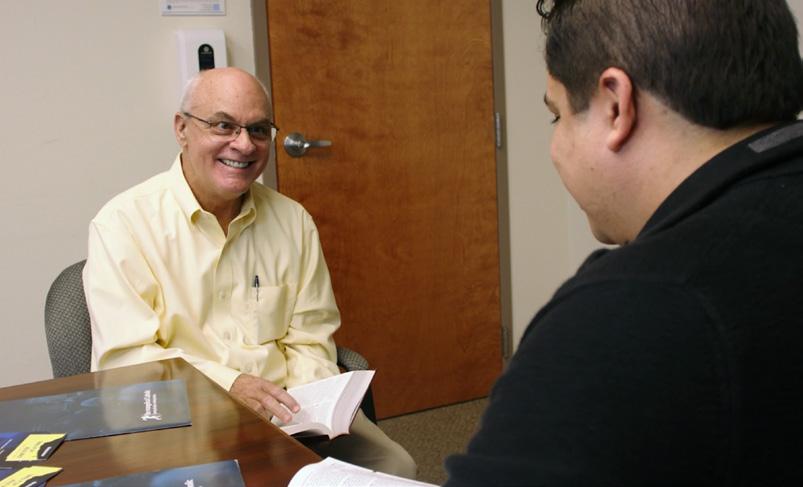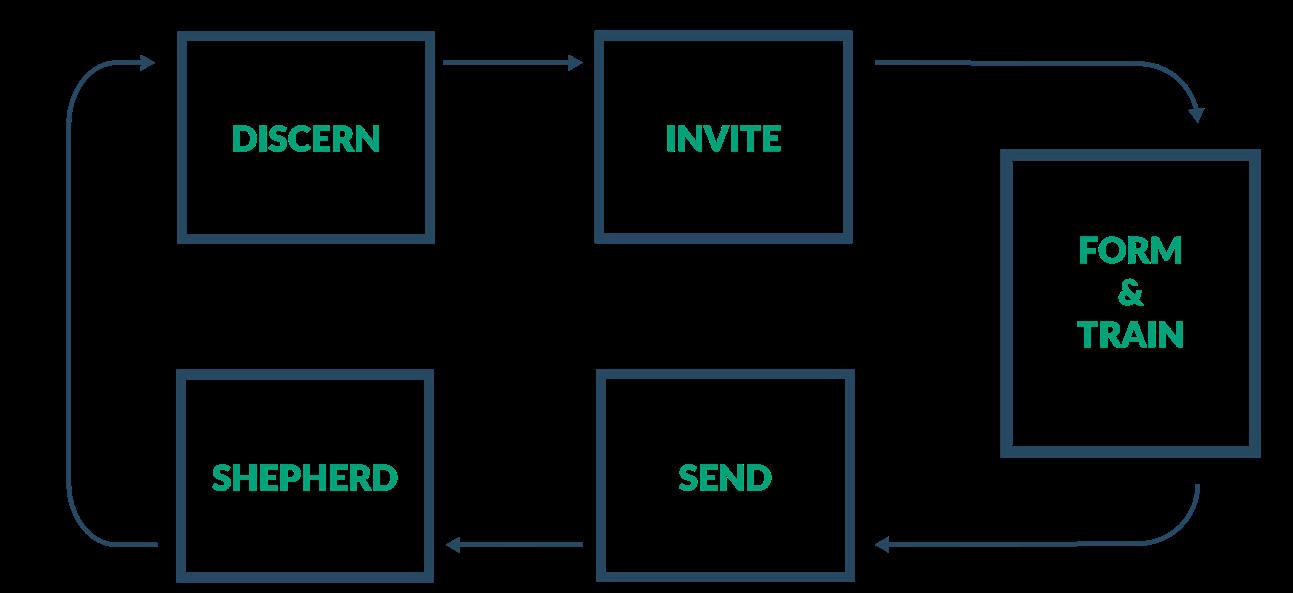
9 minute read
A New Paradigm, an Ancient Process
CHAPTER 3 A NEW PARADIGM, AN ANCIENT PROCESS
To overcome the experiential gap of many pastoral workers and to stop recycling structures ill-fit for our age, what we need is a complete reversal of the paradigm. I will say it in three ways. Rather than trying to draw people to the turf of the parish, asking them to serve the parish and get involved in “parish life,” the ministry structures of the parish ought to serve the faithful by forming and encouraging them to more effectively engage secular life, on their turf.
Advertisement
Rather than the parish functioning as the engine for evangelization and the people the fuel or means for building up the parish, the lay faithful need to function as the engine for evangelization and the parish ministry structures as the fuel or means, providing them with the formation, sacraments, governance/ordering of goods, and charisms essential for apostolic holiness.1
1 In this paradigm, the primacy of the Marian dimension of the Church is protected (as end), and the Petrine dimension retains its proper place as means. See Catechism of the Catholic Church, 773.
Rather than the parish being seen as a center of evangelization, as if the primary locus of evangelization happens at the parish property (essentially bobber fishing), the parish must be seen as a center of apostolic formation for the laity: forming and equipping the laity to “put out into deep water and lower [their] nets for a catch” (Luke 5:4) and shepherding them along the way.
But how are we supposed to change this paradigm with such an impoverished imagination for what lay agency and parish ministry in a missionary tone looks like? Those engaged with evangelization likely know the familiar saying: “It’s not so much that the Church has a mission but that God’s mission has a Church.” There’s a lot of nuance to be aware of in this statement, but for our purposes, it is generally a helpful way to think. So let’s take a moment to observe, in broad strokes, how God himself established and expanded his mission-Church.
Jesus’ Mission Process
For us men and for our salvation Jesus was incarnate of the Virgin Mary. Jesus is God and the mission of God. He is “God Saves.” His mission was and is to reconcile the world back to the Father. He had less than three years to accomplish this mission, and he knew it. So what did he do?
When we think of Jesus’ public ministry, we tend to forget a key ingredient—arguably the most important one: he called twelve men “to be with him” (Mark 3:14).
When we think of Jesus’ public ministry, we readily recall how he taught the multitudes, performed miracles, and traveled from town to town; but we tend to forget a key ingredient in his ministry—arguably the most important one. It is the reason we are here today, and why we even know about the other things Jesus did.
Early on in his public ministry, as he was building a following
Chapter 3 | A New Paradigm, an Ancient Process 35 of disciples, he discerned from among them those whom he called “to be with him” (Mark 3:14), whom he formed, trained, and eventually sent as apostles. He aimed to replicate himself in them, so he could send them to the ends of the earth, to “make disciples of all nations” (Matthew 28:19), to “preach the gospel to every creature” (Mark 16:15), and to reconcile it all back to the Father (cf. Ephesians 2:14-18).
The Gospels tell us that even during those few years, Jesus sent out his disciples on two different occasions. He instructed them to preach the kingdom, and afterwards he processed their experiences with them—almost like practicums! They were
already beginning to own the mission. Then at the end of his earthly mission, Jesus sent the Holy Spirit to fully constitute the Church in mission, as the continuation of his Incarnation. He gave Peter (and his successors) to build and shepherd the Church. The Church became simultaneously the communion of humankind with God and the mission of God to humankind.
Thus we can see that Jesus used a rather simple “mission process” to establish his Church, both as his kingdom and as the mission of his kingdom. To build his Kingdom-Mission: 1) He discerned from among his disciples. 2) He called those who he discerned to be with him. 3) He formed and trained them as apostles to the world. 4) He sent them into the world. 5) He continually shepherds them in the world.
Jesus’ Mission Process

Once they were sent, what did they do? Since imagination is shaped by experience, they did what they had experienced. Wherever they moved, they entered into relationships with people, and they discerned and called those who had the disposition to be formed, trained, and sent for mission—mission to their families, friends, workplaces, and in some cases to other lands. And those who joined the mission were shepherded within these early Christian communities. This process became the general modus operandi of the Church’s growth throughout the centuries. It is the basic way that saints founded and grew orders and movements of renewal in the Church. It is the way in which the various ecclesial movements in the Church continue to grow today.
Applying Jesus’ Mission Process to the Parish
Notice how Jesus did not start with a strategic plan, charts, timelines, or structures that he shoehorned people into. He began by forming a small number of men how to live. As they lived in his new life and attracted people, and as the movement grew, they eventually discerned how to add structures to facilitate ongoing growth.2
2 See Acts 6:1-7; 14:23.
Chapter 3 | A New Paradigm, an Ancient Process 37 This is not unique to Jesus. For example, St. Anthony, St. Francis, and St. Josemaria Escrivá all started something new within the church, something that hadn’t existed before they responded to a call of the Holy Spirit. In all cases, as they began living in a new way, others joined them. It was only after living in these new ways for many years did they write rules and statutes or create structures to protect these realities and allow them to flourish.
Likewise, becoming an apostolic parish does not begin by crafting multi-year strategic plans, rewriting mission statements, and restructuring, as if pastoral leaders could simply herd hundreds or thousands of people en masse into spiritual renewal. It does not begin by getting more people involved in ministries and programs, simply fuel for the engine of the old maintenance paradigm. And it does not begin by trying to engage the lukewarm or by enticing people who aren’t even going to church.
Transitioning from maintenance to mission begins as a mustard seed. It starts with a few disciples who have the disposition to be formed and trained for personal apostolate to their spheres of influence, in their jurisdiction, on their turf. This is an application of an extremely important principle for fruitful ministry: that which is received is received according to the disposition of the receiver.3
Ministry staff have very limited time and resources. In order to be maximally fruitful with the little resources they do have, they must prioritize investing in people with the best disposition to receive formation for mission: people who are already living lives of discipleship, who want to evangelize. In this way, they will begin like Jesus, St. Anthony, St. Francis, St. Josemaria, and numerous other founders of renewal.
3 Cf. Thomas Aquinas, Summa theologica, Vol. 1, 1ae, 1a, q. 75, a. 5; 1a, q. 12, a. 4; and “Questiones Disputatae de Veritate” q. 2, a. 3.
Every parish already has dozens of disciples with the desire to live and share their faith more effectively. They may be daily Mass goers, volunteers, strong Catholic parents who send their kids to the parish school, people who already attend formation offerings, etc.

These people, who are already disciples, are most ready to be formed as missionary disciples. Once formed, they can reach the lukewarm in the pews, the nominal Catholics with kids in the parish school, and the myriad others from all walks of life not going to church, because they are those peoples’ peers, coworkers, family members, neighbors, etc. These missionary disciples will engage people on their own turf, with an effectiveness that pastoral workers cannot dream of. Why? Because they will be functioning in their jurisdiction, within the context of authentic personal relationships. Pastoral workers do not have access to the missionary disciple’s circle of connections, and their connections do not desire to be engaged by pastoral workers.
It turns out, the first step for our parishes to move from maintenance to mission is, in a certain sense, to forget about the parish!4 For their ministry to be fruitful, pastoral workers must prioritize work within their circle of influence. Doing so increases their effectiveness. The opposite also applies: prioritizing work
4 I am speaking in hyperbole here. I am not suggesting we forget about the sacraments. However, an important principle for effective pastoral work is to prioritize work within one’s circle of greatest influence, impact, and effectiveness.
within their circle of concern (all the things they are concerned about, but have little-to-no influence on) decreases their effectiveness.5
The more pastoral workers focus on building “parish life,” ministry structures, and programs; the more they keep trying to engage the lukewarm and unchurched, the less effective they will be. With their focus and time tied up in fruitless pursuits, they will not be able to engage the individuals who actually desire and have the disposition to be formed as missionary disciples. Moreover, they run the risk of burning themselves out. Focusing on the thousand-and-one things and people in their circle of concern instead of focusing on the people in their circle of influence is severely draining of both time and emotional bandwidth, because they will perpetually be fighting a losing battle trying to engage those who do not want to be engaged and form those who are not ready for formation. Moving from maintenance to mission in parish ministry, requires a laser focus on the few. It requires pastoral workers to systematically find, form, and send those who most desire to be missionary disciples, and to shepherd them as they draw others into discipleship. This is the new (and the oldest) paradigm necessary for the parish to live out its deepest identity and vocation. The parish will evangelize the world when it effectively equips and empowers its members to bear apostolic fruit in their secular lives. It is time for parishes to turn their energy, time, and budgets towards equipping the laity to live their vocation in and to the world.
5 For more on circles of influence and concern and how to increase proactivity and effectiveness, see Stephen Covey’s classic book 7 Habits of Highly Effective People.






